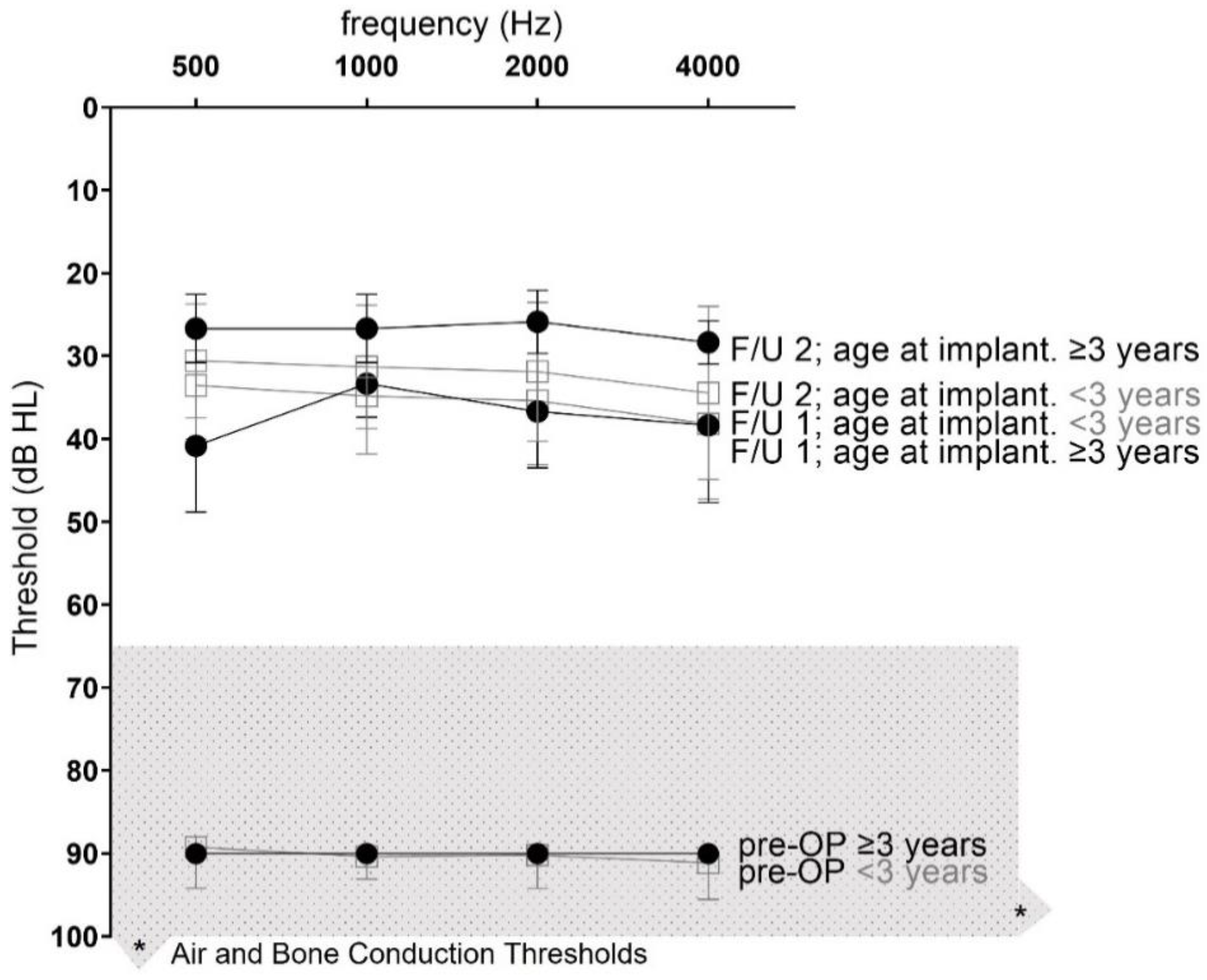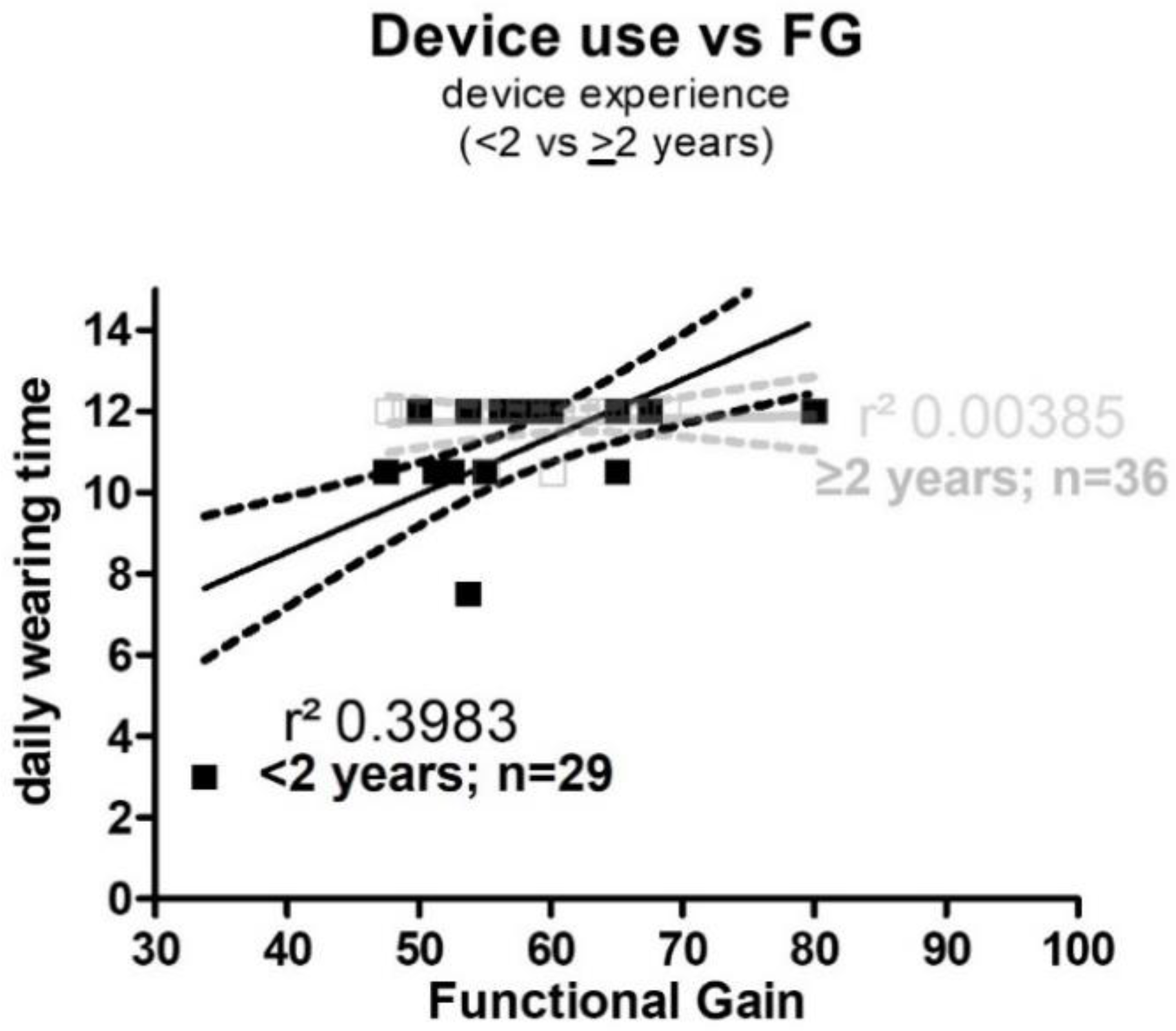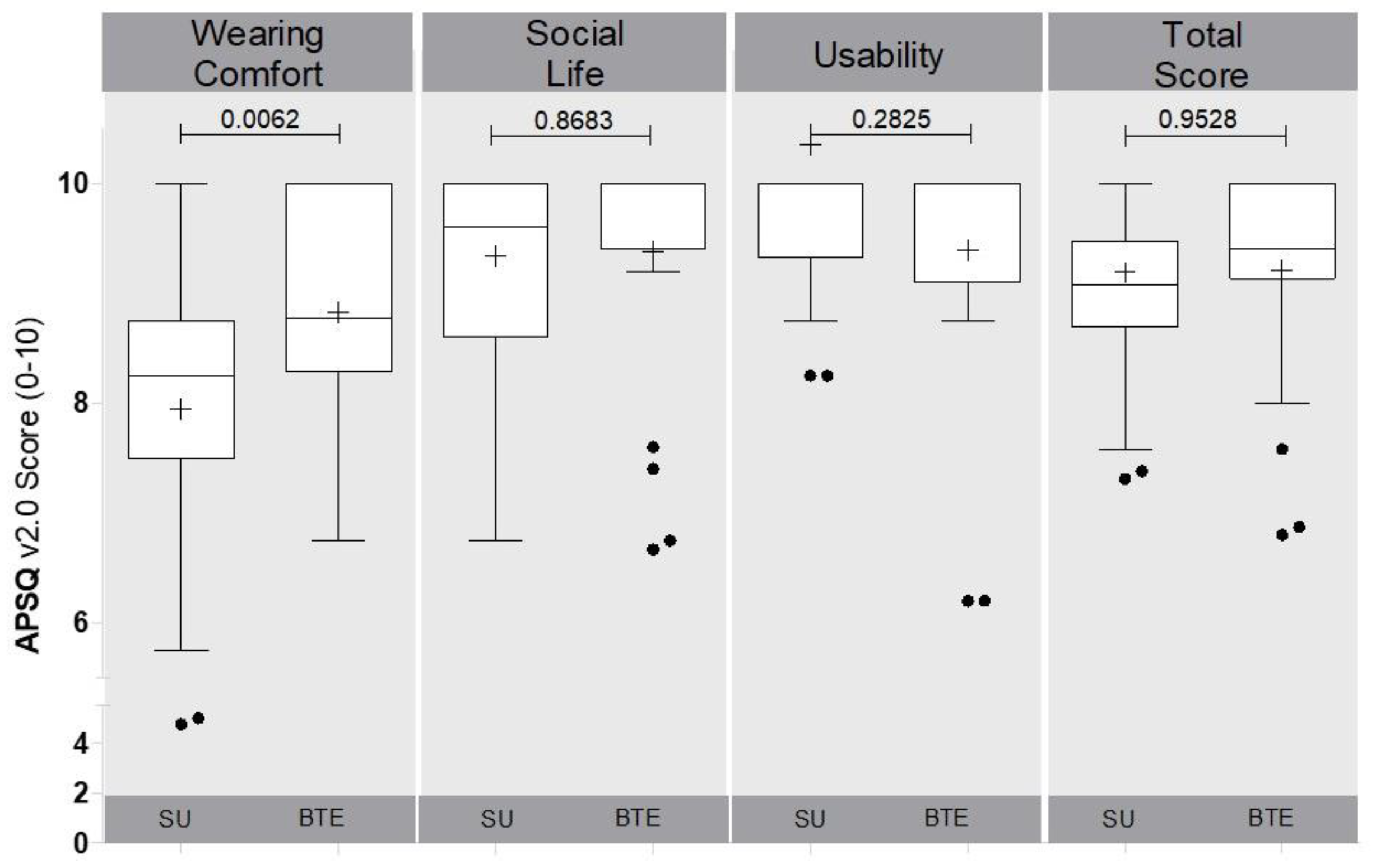Long-Term Device Satisfaction and Safety after Cochlear Implantation in Children
Abstract
1. Introduction
2. Materials and Methods
2.1. Study Population
2.2. Audiological Evaluations
2.3. Satisfaction Related Questionnaire
2.4. Data Analysis
3. Results
3.1. Subjects and Surgical Results
3.2. Audiological Outcomes
3.2.1. Functional Gain in Relation to Age at Implantation
3.2.2. Functional Gain in Relation to Length of Follow-Up
3.2.3. Functional Gain in Relation to Daily Wearing Time
3.3. Audio Processor Satisfaction Questionnaire (APSQ)
3.4. APSQ as a Function of Type of Audio Processor
3.5. APSQ in Relation to Length of Follow-Up
3.6. Safety
- (1)
- Major complications
- (2)
- Minor complications: medical background related
- (3)
- Minor complications: external device related
4. Discussion
5. Conclusions
Author Contributions
Funding
Institutional Review Board Statement
Informed Consent Statement
Data Availability Statement
Conflicts of Interest
References
- Sladen, D.P.; Zappler, A. Older and younger adult cochlear implant users: Speech recognition in quiet and noise, quality of life, and music perception. Am. J. Audiol. 2015, 24, 31–39. [Google Scholar] [CrossRef] [PubMed]
- Capretta, N.R.; Moberly, A.C. Does quality of life depend on speech recognition performance for adult cochlear implant users? Laryngoscope 2016, 126, 699–706. [Google Scholar] [CrossRef] [PubMed]
- Phan, J.; Houston, D.M.; Ruffin, C.; Ting, J.; Holt, R.F. Factors Affecting Speech Discrimination in Children with Cochlear Implants: Evidence from Early-Implanted Infants. J. Am. Acad. Audiol. 2016, 27, 480–488. [Google Scholar] [CrossRef] [PubMed]
- Chweya, C.M.; May, M.M.; DeJong, M.D.; Baas, B.S.; Lohse, C.M.; Driscoll, C.L.W.; Carlson, M.L. Language and Audiological Outcomes Among Infants Implanted Before 9 and 12 Months of Age Versus Older Children: A Continuum of Benefit Associated With Cochlear Implantation at Successively Younger Ages. Otol. Neurotol. 2021, 42, 686–693. [Google Scholar] [CrossRef] [PubMed]
- Dunn, C.C.; Walker, E.A.; Oleson, J.; Kenworthy, M.; Van Voorst, T.; Tomblin, J.B.; Ji, H.; Kirk, K.I.; McMurray, B.; Hanson, M.; et al. Longitudinal speech perception and language performance in pediatric cochlear implant users: The effect of age at implantation. Ear Hear. 2014, 35, 148–160. [Google Scholar] [CrossRef]
- Ramirez-Inscoe, J.; Moore, D.R. Processes that influence communicative impairments in deaf children using cochlear implants. Ear Hear. 2011, 32, 690–698. [Google Scholar] [CrossRef] [PubMed]
- Warner-Czyz, A.D.; Wiseman, K.B.; Nelson, J.A. Quantitative and Qualitative Perspectives of Siblings of Children with Cochlear Implants. J. Speech Lang. Hear. Res. 2021, 64, 2854–2869. [Google Scholar] [CrossRef]
- Fagan, M.K. Frequency of vocalization before and after cochlear implantation: Dynamic effect of auditory feedback on infant behavior. J. Exp. Child Psychol. 2014, 126, 328–338. [Google Scholar] [CrossRef][Green Version]
- Fagan, M.K. Why repetition? Repetitive babbling, auditory feedback, and cochlear implantation. J. Exp. Child Psychol. 2015, 137, 125–136. [Google Scholar] [CrossRef]
- Fagan, M.K. Cochlear implantation at 12 months: Limitations and benefits for vocabulary production. Cochlear Implant. Int. 2015, 16, 24–31. [Google Scholar] [CrossRef]
- Holman, M.A.; Carlson, M.L.; Driscoll, C.L.; Grim, K.J.; Petersson, R.S.; Sladen, D.P.; Flick, R.P. Cochlear implantation in children 12 months of age and younger. Otol. Neurotol. 2013, 34, 251–258. [Google Scholar] [CrossRef] [PubMed]
- McKinney, S. Cochlear implantation in children under 12 months of age. Curr. Opin. Otolaryngol. Head Neck Surg. 2017, 25, 400–404. [Google Scholar] [CrossRef] [PubMed]
- Yang, Y.; Chen, M.; Zheng, J.; Hao, J.; Liu, B.; Liu, W.; Li, B.; Shao, J.; Liu, H.; Ni, X.; et al. Clinical evaluation of cochlear implantation in children younger than 12 months of age. Pediatr. Investig. 2020, 4, 99–103. [Google Scholar] [CrossRef] [PubMed]
- Papsin, B.C. Cochlear implantation in children with anomalous cochleovestibular anatomy. Laryngoscope 2005, 115, 1–26. [Google Scholar] [CrossRef]
- Vieira, S.S.; Dupas, G.; Chiari, B.M. Cochlear implant: The family’s perspective. Cochlear Implants Int. 2018, 19, 216–224. [Google Scholar] [CrossRef]
- Chiossi, J.S.C.; Hyppolito, M.A. Effects of residual hearing on cochlear implant outcomes in children: A systematic-review. Int. J. Pediatr. Otorhinolaryngol. 2017, 100, 119–127. [Google Scholar] [CrossRef]
- Holzinger, D.; Dall, M.; Sanduvete-Chaves, S.; Saldana, D.; Chacon-Moscoso, S.; Fellinger, J. The Impact of Family Environment on Language Development of Children With Cochlear Implants: A Systematic Review and Meta-Analysis. Ear Hear. 2020, 41, 1077–1091. [Google Scholar] [CrossRef]
- Gatehouse, S.; Noble, W. The Speech, Spatial and Qualities of Hearing Scale (SSQ). Int. J. Audiol. 2004, 43, 85–99. [Google Scholar] [CrossRef]
- Zarifian, T.; Movallali, G.; Fotuhi, M.; Harouni, G.G. Validation of the Persian version of the LittlEARS((R)) auditory questionnaire for assessment of auditory development in children with normal hearing. Int. J. Pediatr. Otorhinolaryngol. 2019, 123, 79–83. [Google Scholar] [CrossRef]
- Schaefer, K.; Coninx, F.; Fischbach, T. LittlEARS auditory questionnaire as an infant hearing screening in Germany after the newborn hearing screening. Int. J. Audiol. 2019, 58, 468–475. [Google Scholar] [CrossRef]
- Rauhamaki, T.; Lonka, E.; Lipsanen, J.; Laakso, M. Assessment of early auditory development of very young Finnish children with LittlEARS((R)) Auditory Questionnaire and McArthur Communicative Developmental Inventories. Int. J. Pediatr. Otorhinolaryngol. 2014, 78, 2089–2096. [Google Scholar] [CrossRef] [PubMed]
- Persson, A.; Miniscalco, C.; Lohmander, A.; Flynn, T. Validation of the Swedish version of the LittlEARS((R)) Auditory Questionnaire in children with normal hearing—A longitudinal study. Int. J. Audiol. 2019, 58, 635–642. [Google Scholar] [CrossRef] [PubMed]
- Obrycka, A.; Lorens, A.; Padilla Garcia, J.L.; Piotrowska, A.; Skarzynski, H. Validation of the LittlEARS Auditory Questionnaire in cochlear implanted infants and toddlers. Int. J. Pediatr. Otorhinolaryngol. 2017, 93, 107–116. [Google Scholar] [CrossRef] [PubMed]
- Kayode, O.; Adeyemo, A.A. The Yoruba version of LittlEARS Auditory Questionnaire: Evaluation of auditory development in children with normal hearing. J. Otol. 2018, 13, 92–96. [Google Scholar] [CrossRef]
- Obrycka, A.; Lorens, A.; Walkowiak, A.; Wlodarczyk, E.; Dziendziel, B.; Skarzynski, P.H.; Skarzynski, H. The COVID-19 pandemic and upgrades of CI speech processors for children: Part II-hearing outcomes. Eur. Arch. Otorhinolaryngol. 2022, 14, 1–9. [Google Scholar] [CrossRef]
- Billinger-Finke, M.; Bracker, T.; Weber, A.; Amann, E.; Anderson, I.; Batsoulis, C. Development and validation of the audio processor satisfaction questionnaire (APSQ) for hearing implant users. Int. J. Audiol. 2020, 59, 392–397. [Google Scholar] [CrossRef]
- Wiseman, K.B.; Warner-Czyz, A.D.; Kwon, S.; Fiorentino, K.; Sweeney, M. Relationships Between Daily Device Use and Early Communication Outcomes in Young Children With Cochlear Implants. Ear Hear. 2021, 42, 1042–1053. [Google Scholar] [CrossRef]
- Bugden, S.; Park, A.T.; Mackey, A.P.; Brannon, E.M. The neural basis of number word processing in children and adults. Dev. Cogn. Neurosci. 2021, 51, 101011. [Google Scholar] [CrossRef]
- Gagnon, E.B.; Eskridge, H.; Brown, K.D. Pediatric cochlear implant wear time and early language development. Cochlear Implants Int. 2020, 21, 92–97. [Google Scholar] [CrossRef]
- Busch, T.; Vermeulen, A.; Langereis, M.; Vanpoucke, F.; van Wieringen, A. Cochlear Implant Data Logs Predict Children’s Receptive Vocabulary. Ear Hear. 2020, 41, 733–746. [Google Scholar] [CrossRef]
- Wie, O.B.; Torkildsen, J.V.K.; Schauber, S.; Busch, T.; Litovsky, R. Long-Term Language Development in Children with Early Simultaneous Bilateral Cochlear Implants. Ear Hear. 2020, 41, 1294–1305. [Google Scholar] [CrossRef] [PubMed]
- Geal-Dor, M.; Tranovsky, Y.; Boudilovsky, E.; Adelman, C.; Adler, M.; Levi, H. Acquisition of early auditory milestones with a cochlear implant. Int. J. Pediatric Otorhinolaryngol. 2013, 77, 1852–1855. [Google Scholar] [CrossRef] [PubMed]
- May-Mederake, B.; Dettman, S.J.; Wall, E.; Constantinescu, G.; Dowell, R.C. Early intervention and assessment of speech and language development in young children with cochlear implants. Int. J. Pediatric Otorhinolaryngol. 2012, 76, 939–946. [Google Scholar] [CrossRef] [PubMed]
- Spencer, L.; Oleson, J.J. Early Listening and Speaking Skills Predict Later Reading Proficiency in Pediatric Cochlear Implant Users. Ear Hear. 2008, 29, 270–280. [Google Scholar] [CrossRef] [PubMed]
- Briaire, J.J.; Indian Research, G.; Buchner, A.; Auletta, G.; Arroyo, H.; Zoilo, C.; Mancini, P.; Buhagiar, R.; Vaid, N.; Mathias, N. Survey of Cochlear Implant User Satisfaction with the Neptune Waterproof Sound Processor. Audiol. Res. 2016, 6, 146. [Google Scholar] [CrossRef] [PubMed]
- Dazert, S.; Thomas, J.P.; Buchner, A.; Muller, J.; Hempel, J.M.; Lowenheim, H.; Mlynski, R. Off the ear with no loss in speech understanding: Comparing the RONDO and the OPUS 2 cochlear implant audio processors. Eur. Arch. Otorhinolaryngol. 2017, 274, 1391–1395. [Google Scholar] [CrossRef]
- Niparko, J.K.; Tobey, E.A.; Thal, D.J.; Eisenberg, L.S.; Wang, N.Y.; Quittner, A.L.; Fink, N.E. Spoken language development in children following cochlear implantation. JAMA 2010, 303, 1498–1506. [Google Scholar] [CrossRef]
- Karltorp, E.; Eklöf, M.; Östlund, E.; Asp, F.; Tideholm, B.; Löfkvist, U. Cochlear implants before 9 months of age led to more natural spoken language development without increased surgical risks. Acta. Paediatr. 2020, 109, 332–341. [Google Scholar] [CrossRef]
- Nicholas, J.G.; Geers, A.E. Spoken language benefits of extending cochlear implant candidacy below 12 months of age. Otol. Neurotol. 2013, 34, 532–538. [Google Scholar] [CrossRef]
- Glaubitz, C.; Liebscher, T.; Hoppe, U. Age-related language performance and device use in children with very early bilateral cochlear implantation. Int. J. Pediatr. Otorhinolaryngol. 2021, 147, 110780. [Google Scholar] [CrossRef]
- Purcell, P.L.; Deep, N.L.; Waltzman, S.B.; Roland, J.T., Jr.; Cushing, S.L.; Papsin, B.C.; Gordon, K.A. Cochlear Implantation in Infants: Why and How. Trends Hear. 2021, 25, 23312165211031751. [Google Scholar] [CrossRef] [PubMed]
- Tufatulin, G.S.; Koroleva, I.V.; Artyushkin, S.A.; Yanov, Y.K. The benefits of underwater vibrostimulation in the rehabilitation of children with impaired hearing. Int. J. Pediatr. Otorhinolaryngol. 2021, 149, 110855. [Google Scholar] [CrossRef] [PubMed]
- Välimaa, T.T.; Kunnari, S.; Aarnisalo, A.; Dietz, A.; Hyvärinen, A.; Laitakari, J.; Mykkänen, S.; Rimmanen, S.; Salonen, J.; Sivonen, V.; et al. Spoken Language Skills in Children With Bilateral Hearing Aids or Bilateral Cochlear Implants at the Age of Three Years. Ear Hear. 2021, 43, 220–233. [Google Scholar] [CrossRef] [PubMed]
- Leigh, J.; Dettman, S.; Dowell, R.; Briggs, R. Communication development in children who receive a cochlear implant by 12 months of age. Otol. Neurotol. 2013, 34, 443–450. [Google Scholar] [CrossRef]
- Black, J.; Hickson, L.; Black, B.; Khan, A. Paediatric cochlear implantation: Adverse prognostic factors and trends from a review of 174 cases. Cochlear Implants Int. 2014, 15, 62–77. [Google Scholar] [CrossRef]
- Baumgartner, W.D.; Pok, S.M.; Egelierler, B.; Franz, P.; Gstoettner, W.; Hamzavi, J. The role of age in pediatric cochlear implantation. Int. J. Pediatr. Otorhinolaryngol. 2002, 62, 223–228. [Google Scholar] [CrossRef]
- Dettman, S.J.; Dowell, R.C.; Choo, D.; Arnott, W.; Abrahams, Y.; Davis, A.; Dornan, D.; Leigh, J.; Constantinescu, G.; Cowan, R.; et al. Long-term Communication Outcomes for Children Receiving Cochlear Implants Younger Than 12 Months: A Multicenter Study. Otol. Neurotol. 2016, 37, e82–e95. [Google Scholar] [CrossRef]
- Van, C.H.; Deriaz, M.; Patrucco-Nanchen, T.; Kos, M. Performances in Prelingual Implanted Children According to the Age of Implantation and the Duration of CI Use. Cochlear Implant. Int. 2010, 11, 268–271. [Google Scholar] [CrossRef]
- Hawker, K.; Ramirez-Inscoe, J.M.; Bishop, D.; Twomey, T.; O’Donoghue, G.M.; Moore, D. Disproportionate Language Impairment in Children Using Cochlear Implants. Ear Hear. 2008, 29, 467–471. [Google Scholar] [CrossRef]
- Huber, M.; Hitzl, W.; Albegger, K. Education and training of young people who grew up with cochlear implants. Int. J. Pediatric Otorhinolaryngol. 2008; ahead of print. [Google Scholar]
- Easwar, V.; Sanfilippo, J.; Papsin, B.; Gordon, K. Impact of Consistency in Daily Device Use on Speech Perception Abilities in Children with Cochlear Implants: Datalogging Evidence. J. Am. Acad. Audiol. 2018, 29, 835–846. [Google Scholar] [CrossRef]
- De Raeve, L. Education and rehabilitation of deaf children with cochlear implants: A multidisciplinary task. Cochlear Implant. Int. 2010, 11 (Suppl. 1), 7–14. [Google Scholar] [CrossRef] [PubMed]
- Wass, M.; Lyxell, B.; Sahle, B.; Asker-Arnason, L.; Ibertsson, T.; Maki-Torkko, E.; Hallgren, M.; Larsby, B. Cognitive skills and reading ability in children with cochlear implants. Cochlear Implant. Int. 2010, 11 (Suppl. 1), 395–398. [Google Scholar] [CrossRef] [PubMed]
- Parent, V.; Codet, M.; Aubry, K.; Bordure, P.; Bozorg-Grayeli, A.; Deguine, O.; Eyermann, C.; Franco-Vidal, V.; Guevara, N.; Karkas, A.; et al. The French Cochlear Implant Registry (EPIIC): Cochlear implantation complications. Eur. Ann. Otorhinolaryngol. Head Neck Dis. 2020, 137 (Suppl. 1), S37–S43. [Google Scholar] [CrossRef]
- Yeung, J.; Griffin, A.; Newton, S.; Kenna, M.; Licameli, G.R. Revision cochlear implant surgery in children: Surgical and audiological outcomes. Laryngoscope 2018, 128, 2619–2624. [Google Scholar] [CrossRef] [PubMed]





| Follow-Up 1 | Follow-Up 2 | ||||||
|---|---|---|---|---|---|---|---|
| Unaided PTA4 (dB HL) | Aided PTA4 (dB HL) | FG (dB) | Mean F/U (Months) | Aided PTA4 (dB HL) | FG (dB) | Mean F/U (Months) | |
| Mean | 90.13 | 35.75 | 54.38 | 1.30 | 31.13 | 59.00 | 2.18 |
| SD | 3.08 | 7.03 | 6.91 | 0.24 | 7.30 | 7.67 | 1.31 |
| Median | 90.00 | 35.00 | 53.75 | 1.50 | 30.00 | 60.00 | 2.00 |
| Min | 78.75 | 21.25 | 33.75 | 1.00 | 18.75 | 33.75 | 0.75 |
| Max | 102.50 | 57.50 | 72.50 | 1.50 | 56.25 | 80.00 | 7.00 |
| APSQ Dimensions | Daily Wearing Time | |||||||
|---|---|---|---|---|---|---|---|---|
| Wearing Comfort | Social Life | Usability | Total Score | APSQ after Surgery (y) | Hours | Total n | Percent (%) | |
| Mean | 8.29 | 9.38 | 9.98 | 9.21 | 2.33 | >12 h | 50 | 76.92 |
| SD | 1.25 | 0.84 | 3.40 | 1.35 | 1.78 | 9–12 h | 12 | 18.46 |
| Median | 8.45 | 9.75 | 10.00 | 9.39 | 2.00 | 6–9 h | 2 | 3.08 |
| Min | 4.75 | 6.67 | 6.20 | 6.80 | 0.50 | 3 h | 1 | 1.54 |
| Max | 10.00 | 10.00 | 34.50 | 17.15 | 7.00 | TOTAL | 65 | 100 |
| # Subjects | # Ears | F/U Incident | Kind of Complicaton | Treatment | Time till Solved (Days) | Latest F/U no Revision (Months) | |
|---|---|---|---|---|---|---|---|
| NO Comp. | 47 | - | No Complications | - | - | 6–85 Months | |
| Mean ± SD | 25.45 ± 29.09 | ||||||
| # Subjects | # Ears | F/U Incident | Kind of Complication | Treatment | Time till Solved (Days) | Latest F/U no Revision (Months) | |
| Minor complication | 01a/RONDO2 | 1 | 2.5 | (A) skin pressure under magnet of AP | AP magnet change | 0 | 21 |
| 05b/Sonnet | 2 | 2.1 | (A) skin pressure under magnet of AP | AP magnet change | 0 | 18 | |
| 06b/RONDO2 | 3 | 7.9 | (A) skin pressure under magnet of AP | AP magnet change | 0 | 26 | |
| 10b/RONDO2 | 4 | 8.2 | (B) redness behind the auricle. otitis media acuta | antibiotics | 7 | 35 | |
| 11b/Opus2 | 5 | 0.3 | (B) retroauricular steamy skin | local desinfection | 3 | 26 | |
| 12a/RONDO2 | 6 | 0.4 | (B) redness in the upper part of wound | antibiotics, local disinfection | 3 | 46 | |
| 12b/RONDO2 | 7 | 18.5 | (B) otitis media acuta l.sin.—spont. perforation | antibiotics, ear lavage | 10 | 46 | |
| 16a/RONDO2 | 8 | 2.7 | (A) skin pressure/redness under magnet of AP | AP magnet change | 0 | 19 | |
| 16b/RONDO2 | 9 | 6 | (A) breaking the AP (fall to the ground) | replacement AP | 0 | 19 | |
| 17b/RONDO3 | 10 | 9.8 | (B) otitis media acuta catarrhalis l.dx. | local antibiotics | 3 | 29 | |
| 24a/Opus2 | 11 | 20.9 | (A) break of the AP | replacement | 0 | 23 | |
| 26a/Sonnet | 12 | 36.4 | (B) otitis media on the right side | antibiotics | 7 | 90 | |
| 26a/Sonnet | 12 | 40.5 | (B) small dehiscence, bleeding wound | antibiotics, local disinfection | 1 | 90 | |
| 29/RONDO2 | 13 | 33.9 | (B) retroauricular flegmona | antibiotics | 10 | 83 | |
| 32/RONDO2 | 14 | 1.7 | (A) skin pressure under magnet of AP | AP magnet change | 20 | 26 | |
| Mean ± SD | 12.79 ± 13.48 | 4.60 ± 6.04 | 39.80 ± 25.39 | ||||
| # Subjects | # Ears | F/U Incident | Kind of Complication | Treatment | Time till Solved (Days) | Latest F/U no Revision (Months) | |
| Major comp. n | 01b/RONDO2 | 1 | 0.2 | (C) wound dehiscence | resuturing | 6 | 21 |
| 25 | 2 | 40 | (C) electrode short-circuit due to the head injury | reimplantation | 7 | 24 | |
| 26b/Sonnet | 3 | 2 | (C) electrode dysfunction on the left side | reimplantation | 120 | 90 | |
| Mean ± SD | 14.09 ± 18.35 | 42.33 ± 54.96 | 45.00 ± 31.84 | ||||
Publisher’s Note: MDPI stays neutral with regard to jurisdictional claims in published maps and institutional affiliations. |
© 2022 by the authors. Licensee MDPI, Basel, Switzerland. This article is an open access article distributed under the terms and conditions of the Creative Commons Attribution (CC BY) license (https://creativecommons.org/licenses/by/4.0/).
Share and Cite
Urík, M.; Šikolová, S.; Hošnová, D.; Kruntorád, V.; Bartoš, M.; Jabandžiev, P. Long-Term Device Satisfaction and Safety after Cochlear Implantation in Children. J. Pers. Med. 2022, 12, 1326. https://doi.org/10.3390/jpm12081326
Urík M, Šikolová S, Hošnová D, Kruntorád V, Bartoš M, Jabandžiev P. Long-Term Device Satisfaction and Safety after Cochlear Implantation in Children. Journal of Personalized Medicine. 2022; 12(8):1326. https://doi.org/10.3390/jpm12081326
Chicago/Turabian StyleUrík, Milan, Soňa Šikolová, Dagmar Hošnová, Vít Kruntorád, Michal Bartoš, and Petr Jabandžiev. 2022. "Long-Term Device Satisfaction and Safety after Cochlear Implantation in Children" Journal of Personalized Medicine 12, no. 8: 1326. https://doi.org/10.3390/jpm12081326
APA StyleUrík, M., Šikolová, S., Hošnová, D., Kruntorád, V., Bartoš, M., & Jabandžiev, P. (2022). Long-Term Device Satisfaction and Safety after Cochlear Implantation in Children. Journal of Personalized Medicine, 12(8), 1326. https://doi.org/10.3390/jpm12081326







